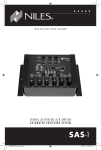Download Russound COMPLEMENT SUB85 Instruction manual
Transcript
Complement ® SUB85 Powered Subwoofer Instruction Manual SAFETY PRECAUTIONS Important Safety Instructions 7. Wall or ceiling Mounting - The appliance should be mounted to a wall or ceiling only as recommended by the manufacturer. WARNING: TO REDUCE THE RISK OF FIRE OR ELECTRIC SHOCK, DO NOT EXPOSE THIS APPLIANCE TO RAIN OR MOISTURE. CAUTION: TO REDUCE THE RISK OF ELECTRIC SHOCK, DO NOT REMOVE COVER. NO USERSERVICEABLE PARTS INSIDE. REFER SERVICING TO QUALIFIED SERVICE PERSONNEL. The lightning flash with arrowhead symbol, within an equilateral triangle, is intended to alert the user to the presence of uninsulated dangerous voltage within the product’s enclosure that may be of sufficient magnitude to constitute a risk of electric shock to persons. 9. Heat - The appliance should be situated away from heat sources such as radiators, heat registers, stoves, or other appliances (including amplifiers) that produce heat. 10. Power Sources - The appliance should be connected to a power supply only of the type described in the operating instructions or as marked on the appliance. 11. Grounding or Polarization - Precaution should be taken so that the grounding or polarization means of an appliance is not defeated. 12. Power Cord Protection - Power supply cords should be routed so that they are not likely to be walked on or pinched by items placed upon or against them, paying particular attention to cords at plugs, receptacles, and the point where they exit from the appliance. The exclamation point within an equilateral triangle is intended to alert the user to the presence of important operating and maintenance (servicing) instructions in the literature accompanying the appliance. 13. Cleaning - The appliance should be cleaned only as recommended by the manufacturer. POWER CORD NOTICE FOR INTERNATIONAL OPERATION 14. Non-use Periods - The power cord of the appliance should be unplugged from the outlet when left unused for a long period of time. To remove all power (supply mains) from the appliance, remove the plug from the wall outlet. For 230V, 50Hz operation, select the power cord for your area. Select the plug for your area at one end and a IEC320 connector at the other. It is not necessary to make any other changes. If you have any questions, call Russound at 603.659.5170. Safety Instructions 1. Read Instructions - All the safety and operating instructions should be read before the appliance is operated. 15. Object and Liquid Entry - Care should be taken so that objects do not fall and liquids are not spilled into the enclosure through the openings. 16. Damage Requiring Service - The appliance should be serviced by qualified service personnel when: A. The power supply cord or the plug has been damaged; or 2. Retain Instructions - The safety and operating instructions should be retained for future reference. B. Objects have fallen, liquid has been spilled into the appliance; or 3. Heed Warnings - All warnings on the appliance in the operating instructions should be adhered to. D. The appliance does not appear to operate normally; or 4. Follow Instructions - All operating and user instructions should be followed. 5. Water and Moisture - The appliance should not be used near water; for example, near a bathtub, washbowl, kitchen sink, laundry tub, in a wet basement, or near a swimming pool. The apparatus shall not be exposed to dripping or splashing liquids and no objects filled with liquids, such as vases, shall be placed on the apparatus. 6. Carts and Stands - The appliance should be used only with a cart or stand that is recommended by the manufacturer. An appliance and cart combination should be moved with care. Quick stops, excessive force and uneven surfaces may cause the appliance and cart combination to overturn. 2 8. Ventilation - The appliance should be situated so that its location or position does not interfere with its proper ventilation. For example, the appliance should not be situated on a bed, sofa, rug, or similar surface that may block the ventilation openings, or placed in a built-in installation, such as a bookcase or cabinet that may impede the flow of air through the ventilation openings. C. The appliance has been exposed to rain; or E. The appliance has been dropped or the enclosure is damaged. 17. Servicing - The user should not attempt to service the appliance beyond that described in the operating instructions. All other servicing should be referred to qualified service personnel. INTRODUCTION Product Description The Complement® SUB85 is a compact, high-powered active subwoofer. Its powerful amplifier couples with an acoustically optimized cabinet and driver to provide high performance with a deep low end and smooth response. Features For installation flexibility, the SUB85 offers stereo linelevel inputs, a line-level LFE input, and stereo speakerlevel inputs with pass-through. An adjustable level control, a variable crossover, and a phase switch allow the user to precisely balance the sub with the other speakers in the audio system. An automatic standby mode turns the subwoofer on as soon as it senses an audio signal and mutes it 20 minutes after the signal ends. A front-panel power indicator glows amber for standby mode and green for fully on. The subwoofer’s attractive compact design provides versatile placement options without compromising the home décor. Applications The SUB85 is ideal for use in small home theater and stereo music systems. The perfect match for Russound Complement LCR7 on-wall speakers, it can also be used with any Russound in-wall or in-ceiling speakers. Subwoofer Placement Room acoustics and modes Room acoustics have a great effect on the sound of speakers, especially subwoofers. When sound is reflected back and forth between two parallel surfaces, such as opposite walls in a rectangular room, it creates standing waves. These make bass response uneven by creating sound peaks and nulls at certain locations within the room. Because the subwoofer’s location affects how standing waves are created, correct subwoofer placement is important to avoid such peaks and nulls. They can’t be fixed by equalization, which could overdrive the speaker and amplifier, causing distortion or damage. The first step toward getting accurate bass response is to set the subwoofer’s crossover to match the low-frequency roll-off point of the main speakers. Once you’ve set the crossover, you can then experiment to find the best possible location for the subwoofer. Corner placement Placing the subwoofer in a corner will result in maximum volume, greatest efficiency, and lowest distortion. This is because the adjacent walls and floor reinforce the fundamental bass tones. However, corner placement can also make the subwoofer sound boomy, emphasizing a single frequency above others and resulting in uneven frequency response. Other placement options To get a smoother, more even frequency response, place the subwoofer at varying distances from the walls of the room. The key to minimizing standing waves is to avoid symmetry. Also, place the subwoofer close to the main speakers. This will help blend and integrate the sound of the sub and the main speakers. At the very least, keep the subwoofer in the front half of the room. A common technique for finding the best location is to put the subwoofer in the main listening position, at seated ear height on a sturdy, nonresonant platform. Play music with ascending and descending bass notes, such as a jazz recording with a walking bass line. Crawl around the floor until you find the spot where the bass sounds smoothest, and where each bass note has about the same volume and clarity. Avoid positions where some notes resonate longer or sound heavier than others. When you’ve found the place where the bass sounds best, put the subwoofer there. Multiple subwoofers Using multiple subwoofers provides greater dynamic range and smoother bass response throughout the room than using only one subwoofer. Placing two subwoofers in the corners behind the main speakers will reduce room resonances and increase directly radiated sound. When placing two subwoofers in adjacent corners, position them asymmetrically to minimize the effects of standing waves. 3 INSTALLATION 2 3 4 5 1 6 10 7 9 8 6 POWER SWITCH – Selects the power state of the internal amplifier. Set to Off to keep the SUB85 off, Auto to turn it on only when it senses an audio signal, or On to keep it turned on all the time. LFE INPUT – RCA connector for a prefiltered low-frequency effects signal from a home theater receiver or processor. 7 PHASE SWITCH – Allows the speaker phase to be inverted to improve acoustic response in some situations. Set to 180° to invert the signal or 0° for no inversion. SPEAKER LEVEL IN – Connectors for speaker-level signals from an amplifier or receiver. Binding posts accept banana plugs, spade lugs, pin connectors, and bare wire up to 12 AWG (2.05 mm). 8 VOLTAGE SWITCH – Sets the amplifier to operate on either 120 V or 240 V. Set this switch to match the supply mains voltage. 3 VOLUME CONTROL – Adjusts the acoustic output level relative to the incoming signal. 9 POWER CORD RECEPTACLE – Connector for the supplied power cord. 4 CROSSOVER FREQUENCY CONTROL – Selects the frequency for the low-pass filter within the range of 50 to 200 Hz. Rear Panel 1 2 5 4 LINE-LEVEL INPUT – RCA connectors for stereo line-level signals from a preamplifier or receiver. 10 SPEAKER LEVEL OUT – Pass-through connectors for main left and right speakers when speakerlevel input is used. Binding posts accept banana plugs, spade lugs, pin connectors, and bare wire up to 12 AWG (2.05 mm). INSTALLATION Connections LFE input The SUB85 gives you multiple options for connecting to your audio system. Choose the option that works best for your particular situation and equipment. The low-frequency effects (LFE) input is for use when the LFE or subwoofer output on the home theater receiver or processor is turned on. Note: Choose only one connection option. Do not combine options. Connect an RCA patch cable between the SUB85’s LFE input and the LFE or subwoofer output on the receiver or processor. Before you connect the SUB85, turn off the power switches on all components, including the subwoofer. Note: The LFE input is not connected to the SUB85’s internal low-pass filter. Accordingly, the crossover frequency control has no effect on a signal entering this input. Use the LFE input only with a signal that is prefiltered by the receiver or processor. Receiver Speaker Outputs Left Line Level Output LFE Output Right Left Right RCA patch cable SUB85 Connection using LFE input 5 INSTALLATION Note: When the LFE or line-level input is connected to an audio system powered by a different electrical circuit from the one used to power the SUB85, a ground loop may result. This causes a low-frequency hum. To eliminate the hum, connect the SUB85 to the same electrical circuit as the audio system or use a ground loop isolator in series with the RCA cable. Connections (continued) Line-level input This input is for use when the receiver’s or processor’s LFE or subwoofer output is turned off, or when the receiver has no LFE or subwoofer output. Connect a stereo RCA patch cable between the SUB85’s line-level input jacks and the front left- and rightchannel line outputs on the receiver or processor. Receiver Speaker Outputs Left Line Level Output LFE Output Right Left Right Stereo RCA patch cable SUB85 Connection using stereo line-level input 6 INSTALLATION Speaker-level input red positive (+) terminal and the black wire to the black negative (–) terminal. This input is for use when you need to send an amplified signal to the SUB85, such as when no line-level signal is available. Note: Some speaker cables have other ways of designating polarity. For example, cable with a clear jacket usually has a copper-colored wire for positive and a silver-colored wire for negative. In a cable with white and black wires, the white is positive and the black is negative. Cable with both wires the same color may have grooves, ribs, or stripes on the positive wire. Use stranded copper speaker cable to connect between the SUB85’s speaker-level input terminals and the front left and right speaker terminals on the receiver or amplifier. The binding posts accept single banana plugs, spade lugs, pin connectors, and bare wire up to 12 AWG (2.05 mm). When you use the speaker-level input on the SUB85, you can connect the main left and right speakers to the speaker-level output terminals. The full-frequency signal will pass through to the main speakers. Be sure to observe proper polarity. For speaker cable with red and black wires, connect the red wire to the Right speaker Left speaker Receiver Speaker Outputs Left Line Level Output LFE Output Right Left Right Connection using speaker-level input with pass-through to main speakers 7 INSTALLATION Power After making the audio connections, make sure the voltage switch on the back of the SUB85 is set to the correct voltage for your area. Insert one end of the power cable into the IEC receptacle next to the voltage switch and the other end into a live power receptacle. Slide the power switch to the Auto setting to place the SUB85 in standby mode or the On setting to place it in full on mode. The power indicator on the front panel will light up amber when the SUB85 is in standby mode and green when fully on. Power receptacle and voltage switch Power switch and audio controls Adjustments Crossover frequency Set the crossover frequency to match the low-frequency roll-off point of the main speakers. If you don’t know the roll-off point, use the following guidelines: • For main speakers with a full frequency range, set the crossover between 50 and 80 Hz. • For main speakers with limited bass extension, set the crossover between 80 and 100 Hz. • For main speakers that reproduce only midrange and high frequencies, set the crossover between 100 and 200 Hz. Your receiver or processor may have a bass management feature with settings for large, medium, and small main speakers. Refer to your equipment manual to determine the appropriate crossover setting if you use this feature. The goal is to set the crossover frequency at the point where the subwoofer reproduces the low frequencies 8 not reproduced by the main speakers, with very little overlap and no gaps in the overall response of the system. To make this adjustment precisely, you can use a calibration CD or DVD and a sound-level meter. Volume Start with the volume set at minimum, raising it gradually until output from the SUB85 sounds about the same volume as output from the main speakers. Again, you can use a sound-level meter to be precise. Phase Depending on the location of the SUB85, its output at certain frequencies may be out of phase with the output of the main speakers. This is especially true when the subwoofer and main speakers are very different distances from the listeners. To compensate for this, try setting the phase switch at both positions. You may find that one position provides smoother bass response than the other. REFERENCE Specifications Speaker type: Front-firing powered subwoofer Driver: 8” (20.3 cm) paper cone woofer Enclosure: Sealed MDF box Finish: Black vinyl wrap with black cloth grille Amplifier power: 80 watts RMS into 4 ohms, 120 watts peak Frequency response: 45–200 Hz ±3 dB Crossover frequency: Variable, 50 Hz – 200 Hz Line inputs: Left, Right, and LFE RCA connectors Speaker inputs: 3-way binding posts Speaker outputs: 3-way binding posts Power requirements: 100–120 V ~60 Hz 1.4 A 220–240 V ~50 Hz 0.7 A Fuse ratings: T2AL 250 V, 100–120 V~ T1AL 250 V, 220–240 V~ Dimensions: 10.16” W x 14.25” H x 12.33” D (25.8 x 36.2 x 31.3 cm) Weight: 20.5 lb (9.3 kg) Warranty The Russound Complement SUB85 is fully guaranteed for two (2) years from the date of purchase against all defects in materials and workmanship. During this period Russound will replace any defective parts and correct any defect in workmanship without charge for either parts or labor. For this warranty to apply, the unit must be installed and used according to its written instructions. If service is necessary, it must be performed by Russound. The unit must be returned to Russound at the owner’s expense and with prior written permission. Accidental damage and shipping damage are not considered defects under the terms of the warranty. Russound assumes no responsibility for defects resulting from abuse or servicing performed by an agency or person not specifically authorized in writing by Russound. Damage to or destruction of components due to improper use voids the warranty. In these cases the repair will be made at the owner’s expense. To return for repairs, the unit must be shipped to Russound at the owner’s expense, along with a note explaining the nature of the service required. Be sure to pack in a corrugated container with at least 3 inches of resilient material to protect the unit from damage in transit. Before returning a speaker for repair, call Russound at 603.659.5170 for a Return Authorization number. Write the RA number on the shipping label and ship to: Russound, ATTN: Service, 5 Forbes Road, Newmarket NH 03857. Russound sells products only through authorized Dealers and Distributors to ensure that customers obtain proper support and service. Any Russound product purchased from an unauthorized dealer or source, including retailers, mail order sellers and online sellers will not be honored or serviced under existing Russound warranty policy. Any sale of products by an unauthorized source or other manner not authorized by Russound shall void the warranty on the applicable product. 9 NOTES 10 NOTES 11 Complement® SUB85 Powered Subwoofer Instruction Manual Russound 5 Forbes Road, Newmarket NH 03857 USA Tel 603.659.5170 • Fax 603.659.5388 www.russound.com Technical Support: [email protected] 28-1276 08/10/07 Copyright © 2007 Russound. All rights reserved. All trademarks are the property of their respective owners. Specifications are subject to change without notice. Russound is not responsible for typographical errors or omissions.












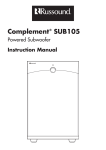
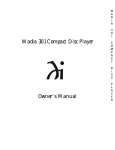
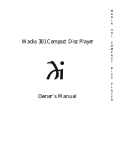
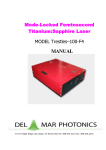
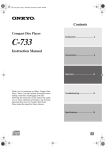
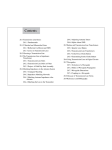


![PS manual[P].qXp2](http://vs1.manualzilla.com/store/data/005858764_1-0e0b40902f5a565498b3e3a041c7e706-150x150.png)
